Data Center
Data Center
A data center (American English) or data centre (British English) is a building, dedicated space within a building, or a group of buildings used to house computer systems and associated components, such as telecommunications and storage systems.
Since IT operations are crucial for business continuity, it generally includes redundant or backup components and infrastructure for power supply, data communications connections, environmental controls (e.g. air conditioning, fire suppression) and various security devices. A large data center is an industrial-scale operation using as much electricity as a small town.
History
Data centers have their roots in the huge computer rooms of the 1940s, typified by ENIAC, one of the earliest examples of a data center. Early computer systems, complex to operate and maintain, required a special environment in which to operate. Many cables were necessary to connect all the components, and methods to accommodate and organize these were devised such as standard racks to mount equipment, raised floors, and cable trays (installed overhead or under the elevated floor). A single mainframe required a great deal of power, and had to be cooled to avoid overheating. Security became important – computers were expensive, and were often used for military purposes. Basic design-guidelines for controlling access to the computer room were therefore devised.
During the boom of the microcomputer industry, and especially during the 1980s, users started to deploy computers everywhere, in many cases with little or no care about operating requirements. However, as information technology (IT) operations started to grow in complexity, organizations grew aware of the need to control IT resources. The advent of Unix from the early 1970s led to the subsequent proliferation of freely available Linux-compatible PC operating-systems during the 1990s. These were called "servers", as timesharing operating systems like Unix rely heavily on the client-server model to facilitate sharing unique resources between multiple users. The availability of inexpensive networking equipment, coupled with new standards for network structured cabling, made it possible to use a hierarchical design that put the servers in a specific room inside the company. The use of the term "data center", as applied to specially designed computer rooms, started to gain popular recognition about this time.
The boom of data centers came during the dot-com bubble of 1997–2000. Companies needed fast Internet connectivity and non-stop operation to deploy systems and to establish a presence on the Internet. Installing such equipment was not viable for many smaller companies. Many companies started building very large facilities, called Internet data centers (IDCs), which provide enhanced capabilities, such as crossover backup: "If a Bell Atlantic line is cut, we can transfer them to ... to minimize the time of outage."
The term cloud data centers (CDCs) has been used. Data centers typically cost a lot to build and to maintain. Increasingly, the division of these terms has almost disappeared and they are being integrated into the term "data center".
Requirements for modern data centers
Modernization and data center transformation enhances performance and energy efficiency.
Information security is also a concern, and for this reason a data center has to offer a secure environment which minimizes the chances of a security breach. A data center must therefore keep high standards for assuring the integrity and functionality of its hosted computer environment.
Industry research company International Data Corporation (IDC) puts the average age of a data center at nine years old. Gartner, another research company, says data centers older than seven years are obsolete. The growth in data (163 zettabytes by 2025) is one factor driving the need for data centers to modernize.
Focus on modernization is not new: Concern about obsolete equipment was decried in 2007, and in 2011 Uptime Institute was concerned about the age of the equipment therein. By 2018 concern had shifted once again, this time to the age of the staff: "data center staff are aging faster than the equipment."
Meeting standards for data centers
The Telecommunications Industry Association's Telecommunications Infrastructure Standard for Data Centers specifies the minimum requirements for telecommunications infrastructure of data centers and computer rooms including single tenant enterprise data centers and multi-tenant Internet hosting data centers. The topology proposed in this document is intended to be applicable to any size data center.
Telcordia GR-3160, NEBS Requirements for Telecommunications Data Center Equipment and Spaces, provides guidelines for data center spaces within telecommunications networks, and environmental requirements for the equipment intended for installation in those spaces. These criteria were developed jointly by Telcordia and industry representatives. They may be applied to data center spaces housing data processing or Information Technology (IT) equipment. The equipment may be used to:
- Operate and manage a carrier's telecommunication network
- Provide data center based applications directly to the carrier's customers
- Provide hosted applications for a third party to provide services to their customers
- Provide a combination of these and similar data center applications
Data center transformation
Data center transformation takes a step-by-step approach through integrated projects carried out over time. This differs from a traditional method of data center upgrades that takes a serial and siloed approach. The typical projects within a data center transformation initiative include standardization/consolidation, virtualization, automation and security.
- Standardization/consolidation: Reducing the number of data centers and avoiding server sprawl (both physical and virtual) often includes replacing aging data center equipment, and is aided by standardization.
- Virtualization: Lowers capital and operational expenses, reduce energy consumption. Virtualized desktops can be hosted in data centers and rented out on a subscription basis. Investment bank Lazard Capital Markets estimated in 2008 that 48 percent of enterprise operations will be virtualized by 2012. Gartner views virtualization as a catalyst for modernization.
- Automating: Automating tasks such as provisioning, configuration, patching, release management and compliance is needed, not just when facing fewer skilled IT workers.
- Securing: Protection of virtual systems is integrated with existing security of physical infrastructures.
Machine room
The term "Machine Room" is at times used to refer to the large room within a Data Center where the actual Central Processing Unit is located; this may be separate from where high-speed printers are located. Air conditioning is most important in the machine room.
Aside from air-conditioning, there must be monitoring equipment, one type of which is to detect water prior to flood-level situations. One company, for several decades, has had share-of-mind: Water Alert. The company, as of 2018, has 2 competing manufacturers (Invetex, Hydro-Temp) and 3 competing distributors (Longden, Northeast Flooring, Slayton).
Raised floor
Although the first raised floor computer room was made by IBM in 1956, and they've "been around since the 1960s," it was the 1970s that made it more common for computer centers to thereby allow cool air to circulate more efficienctly.
The first purpose of the raised floor was to allow access for wiring.
Lights out
The "lights-out" data center, also known as a darkened or a dark data center, is a data center that, ideally, has all but eliminated the need for direct access by personnel, except under extraordinary circumstances. Because of the lack of need for staff to enter the data center, it can be operated without lighting. All of the devices are accessed and managed by remote systems, with automation programs used to perform unattended operations. In addition to the energy savings, reduction in staffing costs and the ability to locate the site further from population centers, implementing a lights-out data center reduces the threat of malicious attacks upon the infrastructure.
Data center levels and tiers
The two organizations in the United States that publish data center standards are the Telecommunications Industry Association (TIA) and the Uptime Institute.
Telecommunications Industry Association
The Telecommunications Industry Association's TIA-942 standard for data centers, published in 2005 and updated four times since, defined four infrastructure levels.
- Level 1 - basically a server room, following basic guidelines
- Level 4 - designed to host the most mission critical computer systems, with fully redundant subsystems, the ability to continuously operate for an indefinite period of time during primary power outages.
Uptime Institute - Data Center Tier Standards
Four tiers are define by the Uptime Institute:
- Tier I: lacks redundant IT equipment, with 99.671% availability, maximum of 1729 minutes annual downtime
- Tier II: adds redundant infrastructure - 99.741% availability (1361 minutes)
- Tier III: adds more data paths, duplicate equipment, and that all IT equipment must be dual-powered (99.982%, 95 minutes)
- Tier IV: all cooling equipment is independently dual-powered; adds Fault-tolerance (99.995%, 26 minutes)
Data center design
The field of data center design has been growing for decades in various directions:
- a 65-story data center has already been proposed
- the number of data centers as of 2016 had grown beyond 3 million USA-wide, and more than triple that number worldwide
Local building codes may govern the minimum ceiling heights and other parameters. Some of the considerations in the design of data centers are:
- size - one room of a building, one or more floors, or an entire building, and can hold 1,000 or more servers
- space, power, cooling, and costs in the data center.
- Mechanical engineering infrastructure - heating, ventilation and air conditioning (HVAC); humidification and dehumidification equipment; pressurization.
- Electrical engineering infrastructure design - utility service planning; distribution, switching and bypass from power sources; uninterruptible power source (UPS) systems; and more.
Design criteria and tradeoffs
- Availability expectations: Cost of avoiding downtime should not exceed the cost of downtime itself
- Site selection: Location factors include proximity to power grids, telecommunications infrastructure, networking services, transportation lines and emergency services. Others are flight paths, neighbouring uses, geological risks and climate (associated with cooling costs).
- Often available power is hardest to change.
High availability
Various metrics exist for measuring the data-availability that results from data-center availability beyond 95% uptime, with the top of the scale counting how many "nines" can be placed after "99%".
Modularity and flexibility
Modularity and flexibility are key elements in allowing for a data center to grow and change over time. Data center modules are pre-engineered, standardized building blocks that can be easily configured and moved as needed.
A modular data center may consist of data center equipment contained within shipping containers or similar portable containers. Components of the data center can be prefabricated and standardized which facilitates moving if needed.
Environmental control
Temperature and humidity are controlled via:
- Air conditioning
- indirect cooling, such as using outside air, Indirect Evaporative Cooling (IDEC) units, and also using sea water.
Electrical power
Backup power consists of one or more uninterruptible power supplies, battery banks, and/or diesel / gas turbine generators.
To prevent single points of failure, all elements of the electrical systems, including backup systems, are typically fully duplicated, and critical servers are connected to both the "A-side" and "B-side" power feeds. This arrangement is often made to achieve N+1 redundancy in the systems. Static transfer switches are sometimes used to ensure instantaneous switchover from one supply to the other in the event of a power failure.
Low-voltage cable routing
Options include:
- Data cabling can be routed through overhead cable trays
- Raised floor cabling, for security reasons and to avoid the addition of cooling systems above the racks.
- Smaller/less expensive data centers without raised flooring may use anti-static tiles for a flooring surface.
Air flow
Air flow management addresses the need to improve data center computer cooling efficiency by preventing the recirculation of hot air exhausted from IT equipment and reducing bypass airflow. There are several methods of separating hot and cold airstreams, such as hot/cold aisle containment and in-row cooling units.
Aisle containment
The rear of the equipment racks are exposed to the room while the aisles containing the fronts of the servers are enclosed with doors and covers, indicating cold aisle containment is being practiced.
Computer cabinets are often organized for containment of hot/cold aisles. Ducting is intended to prevent cool and exhaust air from mixing within server rooms. Rows of cabinets are paired to face each other so that cool air can reach the equipment air intakes and warm air can be returned to the chillers without mixing with the cold air supply.
An alternative to above floor containment is below floor air flow control. A range of underfloor panels can be fitted within the raised floor plenum to create efficient cold air pathways direct to the raised floor vented tiles.
Either the cold aisle or the hot aisle can be contained.
Another alternative method of containment is equipment cabinets with vertical exhaust duct (chimney) Hot exhaust exits the cabinet through the vertical exhaust duct, directing the air into a plenum above a drop ceiling and back to the cooling units or to outside vents, isolating the hot air from the room. With this configuration, traditional hot/cold aisle configuration is not a requirement.
Fire protection
Data centers feature fire protection systems, including passive and Active Design elements, as well as implementation of fire prevention programs in operations. Smoke detectors are usually installed to provide early warning of a fire at its incipient stage.
Two water-based options are
- sprinkler
- mist
- No water - some of the benefits of using chemical suppression (clean agent fire suppression gaseous system).
Security
Physical access is usually restricted. Layered security often starts with fencing, bollards and mantraps. Video camera surveillance and permanent security guards are almost always present if the data center is large or contains sensitive information. Fingerprint recognition mantraps is starting to be commonplace.
Logging access is required by some data protection regulations; some organizations tightly link this to access control systems. Multiple log entries can occur at the main entrance, entrances to internal rooms, and at equipment cabinets. Access control at cabinets can be integrated with intelligent power distribution units, so that locks are networked through the same appliance.
Energy use
Energy use is a central issue for data centers. Power draw ranges from a few kW for a rack of servers in a closet to several tens of MW for large facilities. Some facilities have power densities more than 100 times that of a typical office building. For higher power density facilities, electricity costs are a dominant operating expense and account for over 10% of the total cost of ownership (TCO) of a data center.
Power costs for 2012 often exceeded the cost of the original capital investment. Greenpeace estimated worldwide data center power consumption for 2012 as about 382 billion kWh. Global data centers used roughly 416 TWh in 2016, nearly 40% more than the entire United Kingdom; USA DC consumption was 90 billion kWh.
Greenhouse gas emissions
In 2007 the entire information and communication technologies or ICT sector was estimated to be responsible for roughly 2% of global carbon emissions with data centers accounting for 14% of the ICT footprint. The US EPA estimates that servers and data centers are responsible for up to 1.5% of the total US electricity consumption, or roughly .5% of US GHG emissions, for 2007. Given a business as usual scenario greenhouse gas emissions from data centers is projected to more than double from 2007 levels by 2020.
In an 18-month investigation by scholars at Rice University's Baker Institute for Public Policy in Houston and the Institute for Sustainable and Applied Infodynamics in Singapore, data center-related emissions will more than triple by 2020.
Energy efficiency and overhead
The most commonly used energy efficiency metric of data center energy efficiency is power usage effectiveness (PUE), calculated as the ratio of total power entering the data center divided by the power used by IT equipment.
It measures the percentage of power used by overhead (cooling, lighting, etc.). The average USA data center has a PUE of 2.0, meaning two watts of total power (overhead + IT equipment) for every watt delivered to IT equipment. State-of-the-art is estimated to be roughly 1.2. Google publishes quarterly efficiency from data centers in operation.
The U.S. Environmental Protection Agency has an Energy Star rating for standalone or large data centers. To qualify for the ecolabel, a data center must be within the top quartile of energy efficiency of all reported facilities. The Energy Efficiency Improvement Act of 2015 (United States) requires federal facilities — including data centers — to operate more efficiently. California's title 24 (2014) of the California Code of Regulations mandates that every newly constructed data center must have some form of airflow containment in place to optimize energy efficiency.
European Union also has a similar initiative: EU Code of Conduct for Data Centres.
Energy use analysis and projects
The focus of measuring and analyzing energy use goes beyond what's used by IT equipment; facility support hardware such as chillers and fans also use energy.
In 2011 server racks in data centers were designed for more than 25 kW and the typical server was estimated to waste about 30% of the electricity it consumed. The energy demand for information storage systems was also rising. A high availability data center was estimated to have a 1 mega watt (MW) demand and consume $20,000,000 in electricity over its lifetime, with cooling representing 35% to 45% of the data center's total cost of ownership. Calculations showed that in two years the cost of powering and cooling a server could be equal to the cost of purchasing the server hardware. Research in 2018 has shown that substantial amount of energy could still be conserved by optimizing IT refresh rates and increasing server utilization.
In 2011 Facebook, Rackspace and others founded the Open Compute Project (OCP) to develop and publish open standards for greener data center computing technologies. As part of the project Facebook published the designs of its server, which it had built for its first dedicated data center in Prineville. Making servers taller left space for more effective heat sinks and enabled the use of fans that moved more air with less energy. By not buying commercial off-the-shelf servers, energy consumption due to unnecessary expansion slots on the motherboard and unneeded components, such as a graphics card, was also saved. In 2016 Google joined the project and published the designs of its 48V DC shallow data center rack. This design had long been part of Google data centers. By eliminating the multiple transformersusually deployed in data centers, Google had achieved a 30% increase in energy efficiency. In 2017 sales for data center hardware built to OCP designs topped $1.2 billion and are expected to reach $6 billion by 2021.
Power and cooling analysis
Power is the largest recurring cost to the user of a data center. Cooling is at or below 70 °F (21 °C) wastes money and energy. Furthermore, overcooling equipment in environments with a high relative humidity can expose equipment to a high amount of moisture that facilitates the growth of salt deposits on conductive filaments in the circuitry.
A power and cooling analysis, also referred to as a thermal assessment, measures the relative temperatures in specific areas as well as the capacity of the cooling systems to handle specific ambient temperatures. A power and cooling analysis can help to identify hot spots, over-cooled areas that can handle greater power use density, the breakpoint of equipment loading, the effectiveness of a raised-floor strategy, and optimal equipment positioning (such as AC units) to balance temperatures across the data center. Power cooling density is a measure of how much square footage the center can cool at maximum capacity. The cooling of data centers is the second largest power consumer after servers. The cooling energy varies from 10% of the total energy consumption in the most efficient data centers and goes up to 45% in standard air-cooled data centers.
Energy efficiency analysis
An energy efficiency analysis measures the energy use of data center IT and facilities equipment. A typical energy efficiency analysis measures factors such as a data center's power use effectiveness (PUE) against industry standards, identifies mechanical and electrical sources of inefficiency, and identifies air-management metrics. However, the limitation of most current metrics and approaches is that they do not include IT in the analysis. Case studies have shown that by addressing energy efficiency holistically in a data center, major efficiencies can be achieved that are not possible otherwise.
Computational fluid dynamics (CFD) analysis
This type of analysis uses sophisticated tools and techniques to understand the unique thermal conditions present in each data center—predicting the temperature, airflow, and pressure behavior of a data center to assess performance and energy consumption, using numerical modeling. By predicting the effects of these environmental conditions, CFD analysis in the data center can be used to predict the impact of high-density racks mixed with low-density racks and the onward impact on cooling resources, poor infrastructure management practices and AC failure or AC shutdown for scheduled maintenance.
Thermal zone mapping
Thermal zone mapping uses sensors and computer modeling to create a three-dimensional image of the hot and cool zones in a data center.
This information can help to identify optimal positioning of data center equipment. For example, critical servers might be placed in a cool zone that is serviced by redundant AC units.
Green data centers
Data centers use a lot of power, consumed by two main usages: the power required to run the actual equipment and then the power required to cool the equipment. Power-efficiency reduces the first category.
Cooling cost reduction from natural ways includes location decisions: When the focus is not being near good fiber connectivity, power grid connections and people-concentrations to manage the equipment, a data center can be miles away from the users. 'Mass' data centers like Google or Facebook don't need to be near population centers. Arctic locations can use outside air, which provides cooling, are getting more popular.
Renewable electricity sources are another plus. Thus countries with favorable conditions, such as: Canada, Finland, Sweden, Norway and Switzerland, are trying to attract cloud computing data centers.
Energy reuse
It is very difficult to reuse the heat which comes from air cooled data centers. For this reason, data center infrastructures are more often equipped with heat pumps. An alternative to heat pumps is the adoption of liquid cooling throughout a data center. Different liquid cooling techniques are mixed and matched to allow for a fully liquid cooled infrastructure which captures all heat in water. Different liquid technologies are categorised in 3 main groups, Indirect liquid cooling (water cooled racks), Direct liquid cooling (direct-to-chip cooling) and Total liquid cooling (complete immersion in liquid). This combination of technologies allows the creation of a thermal cascade as part of temperature chaining scenarios to create high temperature water outputs from the data center.
Dynamic infrastructure
Dynamic Infrastructure provides the ability to intelligently, automatically and securely move workloads within a data center anytime, anywhere, for migrations, provisioning, to enhance performance, or building co-location facilities. It also facilitates performing routine maintenance on either physical or virtual systems all while minimizing interruption.
Side benefits include
- reducing cost
- facilitating business continuity and high availability
- enabling cloud and grid computing.
Network infrastructure
Communications in data centers today are most often based on networks running the IP protocol suite. Data centers contain a set of routers and switches that transport traffic between the servers and to the outside world which are connected according to the data center network architecture. Redundancy of the Internet connection is often provided by using two or more upstream service providers (see Multihoming).
Some of the servers at the data center are used for running the basic Internet and intranet services needed by internal users in the organization, e.g., e-mail servers, proxy servers, and DNS servers.
Network security elements are also usually deployed: firewalls, VPN gateways, intrusion detection systems, and so on. Also common are monitoring systems for the network and some of the applications. Additional off site monitoring systems are also typical, in case of a failure of communications inside the data center.
Software/Data Backup
Non-mutually exclusive options for backup are:
- Onsite
- Offsite
Onsite is traditional, and one major advantage is immediate availability.
Offsite backup storage
Data backup techniques includes having an encrypted copy of the data offsite. Methods used for transporting data are:
- having the customer write the data to a physical medium, such as magnetic tape, and then transporting the tape elsewhere
- directly transferring the data to another site during the backup, using appropriate links
- uploading the data "into the cloud"
Modular data center
For quick deployment or disaster recovery, several large hardware vendors have developed mobile/modular solutions that can be installed and made operational in very short time.
Buka juga :




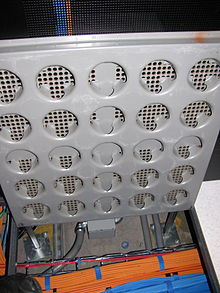
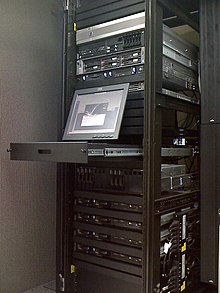


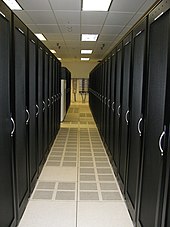

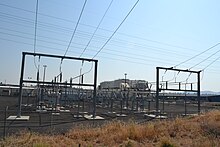



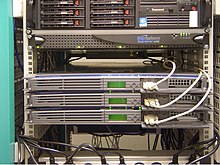
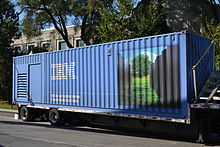
Post a Comment for "Data Center"
Silahkan berkomentar disini